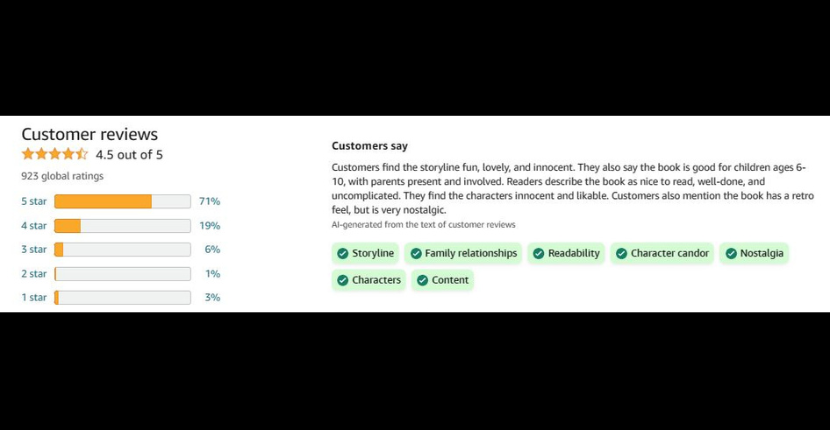 One-Star Reviews:
One-Star Reviews:
Who Doesn’t Like The Happy Hollisters?
A few years ago, an Amazon reviewer wrote that The Happy Hollisters by Jerry West are “great lining for a birdcage.” Ouch! We get it, not everyone loves this series.
This gentleman said he read the books multiple times as he was learning to read as a child, and “. . . the brief dip into the shallow, stagnant end of the pool of available children’s literature didn’t do any lasting harm.” Apparently, he got some benefit from them when he was a child but did not enjoy them as an adult. Fair enough: grown-ups are not the target audience of The Happy Hollisters.
Mary Ann C. recently asked to be removed from our newsletter list and wrote, “My son asked me to buy these books for his twins last year for Christmas. The twins enjoyed the books but we all feel they do not depict much diversity. Also, we found the gender roles very restrictive. We will not be purchasing any more of these books for our children, as we feel they need to be more open to the reality of our time. They were from a long gone era, that some would like to resurrect, but this is not realistic.”
The children were enjoying the books, but Grandma will put a stop to that! We are not fans of taking books away from children who were enjoying them, even if the books portray a bygone time. We think this grandparent missed an opportunity to have a swell discussion with her grandchildren about how culture and language change over time. We believe that the many positive values portrayed by The Happy Hollisters outweigh the occasional outdated material, and that there are still many benefits to reading books written in the past.
Here’s how we responded to Mary Ann:
We understand your misgivings about the dated content in The Happy Hollisters series. We realize that they do not appeal to everyone, but we thank you for giving them a try and sharing your feedback with us.
The first 10 books in the series were written from 1953 to 1955, definitely a different era. Author Andrew Svenson followed the basic creative writing adage: write about what you know. What he knew most about then was a large family living a somewhat insulated life in suburban New Jersey.
The later books, especially those written in the mid-to-late 1960s, started to expand the diversity portrayed in the books. The author himself did on-the-spot research in various countries, such as Mexico, Puerto Rico, Germany, Switzerland, Denmark, Italy, and Iceland, and he met many people who lived a life different from his own. His personal experiences were then transferred into the fictional Hollister family. In the later adventures, the Hollister family encounters more people of different ethnicities, cultures, and physical abilities. They were curious about the differences and always befriended the children they met who spoke other languages, followed unfamiliar customs, or had physical differences. The gender stereotypes also started to undergo a slight shift in the later volumes, with the girls playing more active roles in the sleuthing; still not perfect by today’s standards, but improving.
Andrew Svenson was a partner in the Stratemeyer Syndicate, which produced the Hardy Boys and Nancy Drew, among others. As the mid-1960s became more tumultuous, the Stratemeyer Syndicate—their offices located just a stone’s throw from the Newark riots of 1967—began to revise their books to remove stereotyping of characters and bring the stories more in line with what children (and parents) wanted to experience in books. In 1967, Svenson published The Tollivers Adventure Series under the pen name Alan Stone; it was the first mystery series written specifically to appeal to Black readers. The three books in this series were later repurposed by the Stratemeyer Syndicate and published as Bobbsey Twins books.
Evidence in the author’s files reflects his growing interest in attempting to portray all characters accurately. He wrote to the NAACP for guidance on describing Black characters that appeared in The Tollivers and The Happy Hollisters and the Monster Mystery, for example. He and his assistant spent a day with a blind girl before including a blind character in The Happy Hollisters and the Mystery of the Midnight Trolls. Had he lived beyond 1975, we believe that he might have made revisions in The Happy Hollisters similar to those made in the Hardy Boys in the 1960s and early 1970s.
Thanks again for sharing your family’s viewpoint with us and allowing us the opportunity to explain a little bit about the development of The Happy Hollisters. We will remove you from our mailing list immediately and hope that you find an equally exciting series that is in alignment with your family’s values and will provide you with a lifetime of happy reading.
What do you think? How else can today’s young readers benefit from reading The Happy Hollisters by Jerry West? If you love the series, please considering writing a review or giving us a (better-than-one-star) review of your favorite volume! You can send your review to us at support@thehappyhollisters.com or write one on Amazon! How to Review The Happy Hollisters on Amazon
